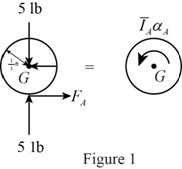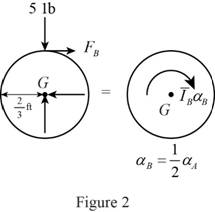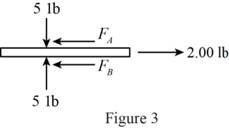
Concept explainers
(a)
Find whether the slipping occurs between the belt and either cylinder.
(a)
Explanation of Solution
The force pulled between cylinders A and B (P) is
The weight of the cylinder A
The weight of the cylinder B
The coefficient of the static friction
The coefficient of the kinetic friction
The radius of the cylinder A
The radius of the cylinder B
Calculation:
Consider the acceleration due to gravity (g) as
Convert the unit of the radius of the cylinder A
Convert the unit of the radius of the cylinder B
Consider that no slipping occurs.
Calculate the acceleration of the belt
Calculate the mass of the cylinder A
Substitute
Calculate the mass of the cylinder B
Substitute
Calculate the mass moment of inertia of the cylinder A
Substitute
Calculate the mass moment of inertia of the cylinder B
Substitute
Show the free body diagram of the cylinder A as in Figure 1.

Here,
Refer to Figure 1.
Calculate the moment about point G by applying the equation of equilibrium:
Substitute
Show the free body diagram of the cylinder B as in Figure 2.

Here,
Refer to Figure 2.
Calculate the moment about point G by applying the equation of equilibrium:
Substitute
Show the free body diagram of the belt as in Figure 3.

Refer to Figure 3.
Calculate the horizontal forces by applying the equation of equilibrium:
Sum of horizontal forces is equal to 0.
Calculate the angular acceleration of the cylinder A
Substitute
Calculate the horizontal force of the cylinder A
Substitute
Calculate the horizontal force of the cylinder B
Substitute
Calculate the magnitude of the friction force
Substitute
The horizontal forces of the cylinder A and B are greater than the magnitude of the friction force
Therefore, there is no slipping occurs between cylinders and belt.
(b)
Find the angular acceleration of each cylinder
(b)
Answer to Problem 16.40P
The angular acceleration of each cylinder
Explanation of Solution
The force pulled between cylinders A and B (P) is
The weight of the cylinder A
The weight of the cylinder B
The coefficient of the static friction
The coefficient of the kinetic friction
The radius of the cylinder A
The radius of the cylinder B
Calculation:
Refer the part (a).
Consider the no slipping occur at cylinder B.
Therefore, the angular acceleration of the cylinder B is
Calculate the angular acceleration of the cylinder A
Substitute
Calculate the angular acceleration of the cylinder B
Substitute
Hence, the angular acceleration of each cylinder
Want to see more full solutions like this?
Chapter 16 Solutions
Vector Mechanics for Engineers: Statics and Dynamics
- 4. A 300-lb cabinet is mounted on casters that can be locked to prevent their rotation. The coefficient of static friction between the floor and each caster is 0.23. Assuming that the casters at both A and B are locked, determine (a) the force Prequired to move the cabinet to the right, (b) the largest allowable value of h if the cabinet is not to tip over. В 24 in.arrow_forwardA clockwise couple M is applied to the circular cylinder as shown. Determine the value of M required to initiate motion for the conditions mg = 4.6 kg, mc - 4.7 kg, (s)B=0.46, (c=0.34, and r=0.21 m. Friction between the cylinder C and the block B is negligible. (s)c Answer: M = mc M mg (₂)B N.marrow_forwardAs shown, a man is leaning against the side of a cabinet with an unusual design. The cabinet's main body weighs 25 kg, while the upper rectangular portion weighs 3 kg. Assume the coefficients of friction between the cabinet and the floor are μs = 0.33 and μk = 0.28. Knowing that the force P exerted by the man's shoulder on the horizontal cabinet: 2. Determine which of the following is the CORRECT equilibrium equation obtained from the system's force diagram. A. ΣF = 0: N - 245.25 = 0B. ΣF = 0: P - μ N = 0C. ΣM = 0: 245.25(0.55) + 29.43(0.2) - N(x) - P(1.5) = 0arrow_forward
- Three packages each of weight m = 9 kg A, B, and C are placed on a conveyor belt that is at rest. Between the belt and both packages A and C, the coefficients of friction are Ms = 0.30 and Mk = 0.20; between package B and the belt, the coefficients are Ms = 0.10 and Mk = 0.08. The packages are placed on the belt so that they are in contact with each other and at rest. Determine which, if any, of the packages will move and the friction force acting on each package. The frictional force acting on A is N The frictional force acting on B is N The frictional force acting on C is N Note: please show correct step by step working out. And double check final answers. Also for frictional force A, B & C show their directions as well. Thanks!arrow_forwardA block with mass of m, = 2 kg is placed on top of a block with a mass m2 = 4 kg. A horizontal force of F=60 N is applied to the block m2, and the block m, is tied to the wall. The coefficient of kinetic friction between all surfaces is 0.400. (a) Draw a free-body diagram for each block and identify the action-reaction forces between the blocks. (b) Determine the tension in the string and the magnitude of the acceleration of the block m2.arrow_forwardIn the system shown two blocks A and B are joined by anegligible ground cable passing through a fixed pulley that does notbroken. Block A has a mass of 45 kg and the coefficients ofstatic friction are 0.40 between rope and pulley and 0.30 betweenblocks and inclined planes. Determine:a) The maximum mass of block B that will cause theblock A slides down.b) The minimum mass of block B that will cause block A to slide up.c) Explain the condition of the system if the mass of block B were 80 kg.arrow_forward
- Two forces, F, and F2, act on the 7.00-kg block shown in the drawing. The angles made by the forces with horizontal are equal to 40°. The magnitudes of the forces are F, = 59.0 N and F2 = 49.0 N. The coefficient of kinetic friction between the block and the surface is 0.1. F2 F1 ...*. ..... а. Draw a free body diagram to show all forces and their components. b. Determine the kinetic friction force. С. What is the horizontal acceleration (magnitude and direction) of the block?arrow_forwardIn the system shown two blocks A and B are joined by anegligible ground cable passing through a fixed pulley that does notbroken. Block A has a mass of 45 kg and the coefficients ofstatic friction are 0.40 between rope and pulley and 0.30 betweenblocks and inclined planes. Determine: a) The maximum mass of block B that will cause theblock A slides down.b) The minimum mass of block B that will cause block A to slide up.c) Explain the condition of the system if the mass of block B were 80 kg.arrow_forward3. A block of mass m = 2.00 kg rests on the left edge of a block of mass M = 8.00 kg. The coefficient of kinetic friction between the two blocks is 0.300, and the surface on which the 8.00 kg block rests is frictionless. A constant horizontal force of magnitude F = 10.0 N is applied to the 2.00-kg block, setting it in motion as shown in Figure. The distance L that the leading edge of the smaller block travels on the larger block is 3.00 m. m (a) Draw a separate free-body diagram for each block. (b) In what time interval will the smaller block make it to the right side of the 8.00-kg block? as (Note: Both blocks are set into motion when the force is applied.) (c) How far does the 8.00-kg block move in the process?arrow_forward
- 3. A block of mass m = 2.00 kg rests on the left edge of a block of mass M= 8.00 kg. The coefficient of kinetic friction between the two blocks is 0.300, and the surface on which the 8.00 kg block rests is frictionless. A constant horizontal force of magnitude F= 10.0N is applied to the 2.00-kg block, setting it in motion as shown in Figure. The distance L that the leading edge of the smaller block travels on the larger block is 3.00 m. F - m M M (a) Draw a separate free-body diagram for each block. (b) In what time interval will the smaller block make it to the right side of the 8.00-kg block? as (Note: Both blocks are set into motion when the force is applied.) (c) How far does the 8.00-kg block move in the process?arrow_forwardQ4.) The 12 kg block A and 10 kg block B are pinned to a rod having negligible mass and resting on horizontal surfaces. A horizontal force P is applied to the rod at end C increasing gradually from zero until motion first begins. a) If the coefficient of static friction between both blocks and each surface is μ = 0.45, determine the value for P at which point motion first begins and describe the motion that occurs in a few brief words. b) If the coefficient of static friction between both blocks and each surface is μ = 0.6, determine the value for P at which point motion first begins and describe the motion that occurs in a few brief words. (Hint: Consider drawing the system as one FBD for this analysis and treat each block as a particle with negligible dimensions) 100 mm 200 mm с Bo 10 kg 25° A 12 kg 12 kgarrow_forwardKnowing that the coefficient of static friction between the tires and the road is 0.8 for the automobile (m=1050 kg) shown, determine 1-normal reaction at front wheel (N), the car is assumed rear wheel drive. 2- normal reaction at rear wheel (N), the car is assumed rear wheel drive. 3- maximum acceleration (m/s2), the car is assumed rear wheel drive.arrow_forward
 International Edition---engineering Mechanics: St...Mechanical EngineeringISBN:9781305501607Author:Andrew Pytel And Jaan KiusalaasPublisher:CENGAGE L
International Edition---engineering Mechanics: St...Mechanical EngineeringISBN:9781305501607Author:Andrew Pytel And Jaan KiusalaasPublisher:CENGAGE L
